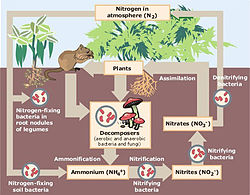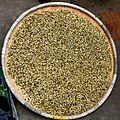Legume

A legume is a type of dry fruit. It is usually produced by plants in the family Fabaceae. Legumes can be a variety of fruits: peas and beans are types of legumes.
Description
Legumes grow from the carpel, the female reproductive part of a plant. The fruit of a legume is found inside a pod that can be split on both sides. However, there are some foods that grow inside pods that are not legumes.
Health
Legumes contain many healthy nutrients, such as protein. They are a good source of protein for vegetarians and vegans, or people who do not eat meat and fish. They also contain fibre. This helps to have a healthy digestive system. However, they contain some nutrients which humans find difficult to digest. It is recommended that legumes are soaked (left in water) before cooking to help with nutrient absorption (taking in more nutrients).[1] Some amino acids, such as methionine, are not found very much in some legumes. However, they are needed to help the body use protein.
Use
India imports (buys from other countries) the most legumes. This may be because a lot of Indians follow the religion of Hinduism, which does not let people eat meat. Legumes are a cheap and plentiful source of food in a country where around 22% of the population are in poverty. The top four producers and exporters (selling to other countries) of legumes are:
The USA uses legumes for a variety of reasons. It is the highest producer. It uses soybeans to feed cattle and make vegetable oil. Peanuts are a popular snack food in the USA and these are also a type of legume.
Legume Media
Legumes play a key role in the nitrogen cycle, making nitrates available to other plants in the soil.
Pulses in a Nanglo tray
Freshly dug peanuts (Arachis hypogaea), indehiscent legume fruits
White clover, a forage crop
Pulses for sale in a Darjeeling market
Related pages
References
- ↑ Sandberg, Ann-Sofie (2002). "Bioavailability of minerals in legumes". British Journal of Nutrition. 88: Suppl. 3, S281–S285. doi:10.1079/BJN/2002718. PMID 12498628. S2CID 5942232. Retrieved 22 February 2016.








